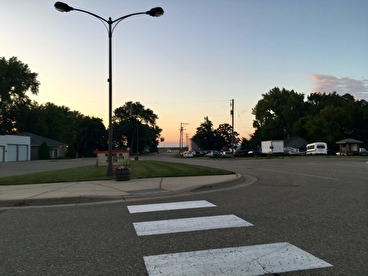
Rural Transportation and Health

Carrie Henning-Smith, Deputy Director, Rural Health Research Center
Areas of Expertise: Rural Health, Health Policy, & Health Equity
Transportation is essential to well-being, yet rural residents face unique challenges in accessing and using transportation of all types. Relative to urban areas, rural communities are losing population, and many struggle to remain economically viable. Their transportation-related challenges include the quality of roads, long distances between resources, fewer sidewalks and other means of active transportation, and limited availability of public transportation and affordable private transportation.
Rural residents have higher rates of motor vehicle fatalities, but health-related transportation issues for rural residents go beyond that grim statistic. Many factors contribute to rural inequities in health. On average, rural residents are older, with fewer financial resources and poorer health outcomes than urban residents. In recent decades, rural areas have seen reductions in access to health care services, including hospitals, pharmacies, obstetric services, and nursing homes. People in rural areas live farther from many resources and opportunities and often need to travel greater distances for jobs, school, health care, errands, and civic and social opportunities than their urban counterparts.
Coupled with declining health care services in rural areas that require residents to travel farther to receive care, it can be logistically challenging—even impossible—to receive the services that one needs.

Fragmented rural transportation can have direct impacts on residents’ health and access to services. When available, rural transit systems can be piecemeal and do not necessarily coordinate services in a way that makes them easy to use for locals. This lack of coordination is a facet of multiple layers of funding and governance—at the federal, tribal, state, regional, and county levels. This makes funding, scheduling, resource sharing, and communication logistically challenging. For example, if someone needs to use public transportation to access specialty health services in a neighboring county, they may need to navigate multiple systems, all with limited route and scheduling availability. Coupled with declining health care services in rural areas that require residents to travel farther to receive care, it can be logistically challenging—even impossible—to receive the services that one needs. On top of that, rural residents are less likely than urban residents to have paid sick leave if they are employed. Altogether, this means more time traveling for services but less financial support for doing so.
Further, a disproportionate percentage of rural residents have mobility-related impairments that make transportation difficult. Rural locales have greater needs for accessible transportation but arguably face more complex challenges in providing it. Volunteer drivers can fill the gap in some situations, but they may face their own underlying health conditions or financial limitations. Indeed, there’s a dearth of volunteers to fill such roles in rural areas, and available volunteers face limits on what they’re able to do because of insurance and safety issues. More formal medical transportation services (including EMS), do serve rural areas. However, these can struggle with staff availability, vehicle fleet capacity, and policies that prohibit reimbursement for miles driven without a patient aboard (such as to reach a patient’s home). Efforts are underway to revise such “loaded mile” policies, but rural residents still struggle with transportation in the moments when they need it most.
Sometimes the best solution is for someone to have care and resources brought directly to their home. However, this raises challenges with transportation for service agencies and staff. For example, home-delivered meal programs can help meet the nutrition and social needs of rural residents unable to travel, but long distances and financial constraints mean some programs can only deliver meals weekly, raising issues of freezer capacity and food safety on top of limited social interaction. Further, for home health care or other agency staff to visit a rural resident’s home, they may need to charge for a prohibitively expensive number of hours in their shift to cover travel time. All of this further inhibits access to health care—and health—for rural residents, especially those with the greatest needs.
It’s important to note that rural people and places are diverse. Not all are struggling with the issues discussed above. Some are thriving. Given this diversity—in demography, geography, and need—the solutions to transportation-related issues will need to be tailored to individual locations and should include input from rural residents themselves.
Rural areas are well-known for being resourceful and innovative. The future of rural mobility may lie in models that already exist. These include a variety of programs designed to increase social connectedness for older adults, and one program that connects volunteer drivers and other transportation options with residents needing rides for health and wellness appointments. Other examples of rural transportation models can be found in the federally funded Rural Health Information Hub’s toolkit.
These models alone are not enough to solve rural transportation problems, however, and will not, on their own, provide the future of rural mobility. Several structural changes are required to ensure that rural residents can connect with one another and the resources they need.